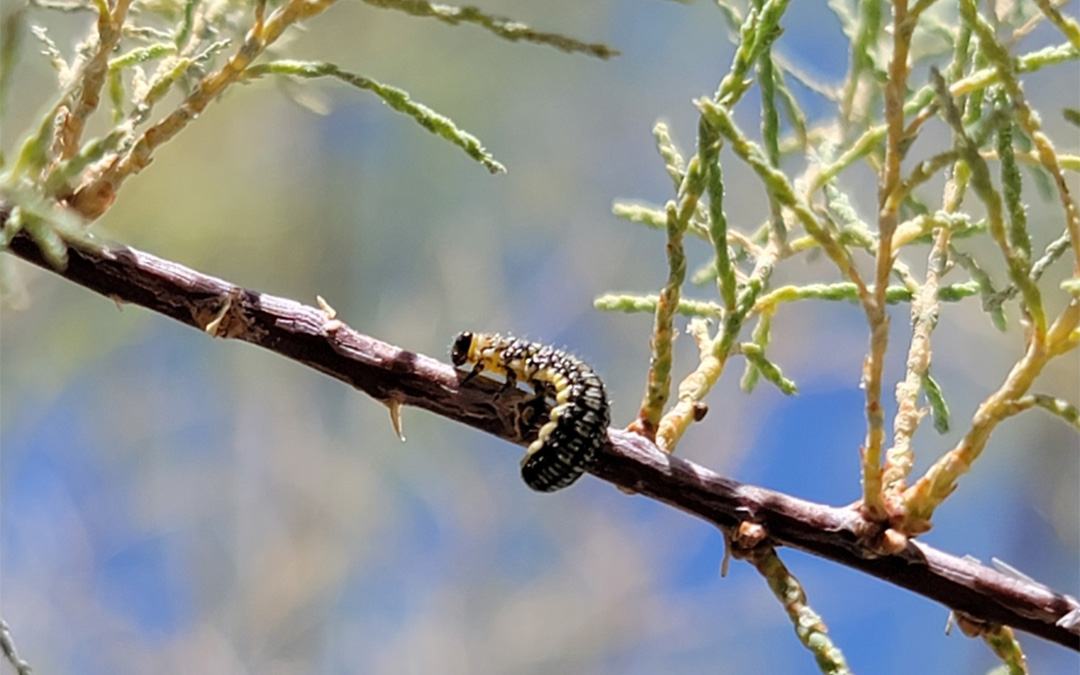Join the September EcoQuest: Tracking Tamarisk Beetles.
WHAT TO OBSERVE:
Find and map as many tamarisk beetles (larvae too!) (Diorhabda spp.) and tamarisk trees (Tamarix spp.) as possible.
Tamarisk beetles, or salt cedar beetles, are small leaf critters that are greenish to light tan in color with four brown stripes running down its back. They are about the size of a ladybug. The larvae are very small and appear completely black in the earliest stage. The second and third stages are characterized by a long yellow stripe running down either side of their abdomen.

Tamarisk beetle observation by @kenziebell2.
Tamarisk beetles were released as a biological control for the invasive tamarisk trees, a wispy bush with feathery pink flowers, in 2001. The beetles and their larvae feed on the tree’s leaves, weakening them and reducing their ability to reproduce. Depending on the location and specific micro-environmental factors, recent research indicates that it may take five to seven years of repeated beetle infestation and defoliation for a tamarisk tree to die The goal is to help control the spread of the tamarisk tree, which suck large amounts of water from the ground and can displace riparian habitat.
The beetles were not expected to survive Arizona’s arid climate, but they have expanded their range much faster and farther than predicted — bringing tricky ecological situations with them. Tamarisk trees may die off faster than intended, leaving native plants struggling to fill habitat fast enough and affecting the endangered Southwestern willow flycatcher (Empidonax traillii ectimus). Other potential issues include restoration challenges, destabilizing riparian banks and the amount of standing dead trees. The beetles can assist with long-term recovery and resiliency of riparian communities, but it is important to acknowledge the potential challenges.
InOctober 2021, EcoFlora project members made the first observations of tamarisk beetles in the Phoenix area on iNaturalist. The beetles ha been observed by scientists in September and Metro Phoenix EcoFlora project member @kenziebell2 was the first to observe them in the area on iNaturalist, followed by @kristen-c and @mchew6. The observations have nearly doubled this year Can you help us find more?
The tamarisk beetle was tested by the U.S. Department of Agriculture for more than 10 years to ensure that it would be effective and not feed on native plants or crops in the Western United States. If you see the beetle or larvae feeding on plants that are not tamarisk, please email [email protected].

Tamarisk beetle larvae observation by @kristen-c.
Observing tamarisk beetles and their larvae can contribute to the efforts of organizations that are tracking their range, activity, and phenology, such as RiversEdge West. Observing the tamarisk trees they feed on can also help us learn where they may move next.
Sources and more information:
RiversEdge West

EcoQuests are month-long challenges that are part of the larger Metro Phoenix EcoFlora project. Learn more by visiting our website.
Look for project happenings, EcoQuest announcements and more in the newsletter, project journal and on social media.

- Please do not observe indoor houseplants or pets.
- For your own safety and the protection of plants and wildlife, do not trespass when making observations.
- Please follow all posted rules and guidelines in parks/preserves and do not enter private property.
- Do not remove or move natural materials (plants, animals, rocks).
- Respect wildlife (do not touch, feed, or disturb animals and keep a safe distance).
Do what’s best for you and your community.
Arizona Office of Tourism: Responsible Recreation in AZ
https://tourism.az.gov/responsible-recreation-across-arizona
